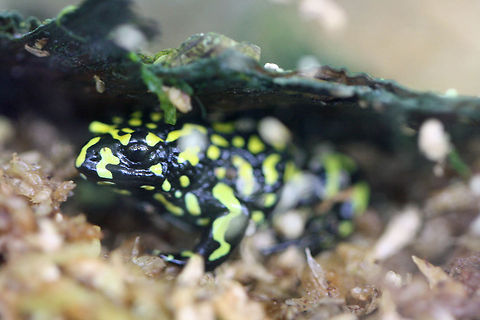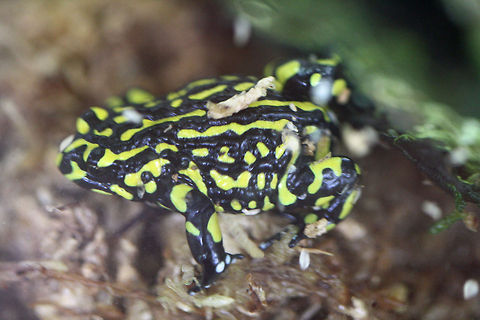
Appearance
The northern form deviates slightly in having narrow yellow to greenish stripes and is slightly smaller.
Distribution
Corroboree frog have different patternsThe Corroboree frog is found only in a 400 km² patch in the sub alpine regions of Southern New South Wales and Victoria, Australia.
Status
Both species have declined dramatically in the past thirty years. However, the Southern Corroboree Frog has suffered from more serious declines.The Southern Corroboree Frog was considered relatively numerous within its very small distribution in the 1970s, as of June 2004 it had an estimated adult population of 64. This species has suffered declines of up to 80% over the past 10 years. It is found only within a fragmented region of less than 10 km² within Mount Kosciuszko National Park in the Snowy Mountains in New South Wales. It is only found at 1300 m above sea level . It is currently listed as critically endangered and is considered to be one of, if not, Australia's most endangered species.The Northern Corroboree Frog has not suffered as badly as the southern. It is more widely distributed across about 550 km² of the Brindabella and Fiery Ranges in Namadgi National Park, Australian Capital Territory, and Kosciuszko National Park and Buccleuch State Forest in New South Wales. It is found above about 1000m and is found to have higher population numbers at lower elevations. It has recently been downgraded from critical to endangered by the IUC finding.The Amphibian Research Centre had already begun a rescue programme under which eggs were collected and raised to late tadpole stage before return as close as possible to their collection site. Research is now underway into captive breeding and on which lifecycle stage - eggs, tadpoles or adults - promises the best chance of survival following return to the wild. The national parks authorities in the Australian Capital Territory and New South Wales have developed conservation programmes, including a captive husbandry programme at Tidbinbilla, ACT, as well as Taronga Zoo in Sydney.
Behavior
Corroborree frogs are quite unusual in their nature. Not only do they not start breeding until four years of age, they also hibernate during winter under whatever shelter they can find. This may be snow gum trees, or bits of bark or fallen leaves. Males stay with the egg nests and may breed with many females over the course of one season....hieroglyph snipped...Reproduction
Sexual maturity of ''P. corroboree'' is reached at four years of age, with one year as an embryo/tadpole and two years as a juvenile/subadult. Adults primarily have only one breeding season. Breeding occurs around December terrestrially near shallow pools, fens, seepages, wet grassland or wet heaths, where the males build chamber nests within the grasses and moss. Males compete for females via song. Each male will attract up to ten females to his burrow sequentially and may dig a new burrow if his first is filled with eggs. The female lays up to 38 eggs and the male grasps her and deposits sperm directly onto the eggs. Tadpoles develop but remain within the protective egg coat until hatching occurs when high ground-water levels after rain cause the nest to become flooded at 4 to 6 months. Tadpole development takes six to eight months. Metamorphosis occurs between December and February .''P. pengilleyi'' prefers to breed in sphagnum bogs and wet heath in sub-alpine areas and dense patches of herbs in openings or seepages amongst fallen tussocks at lower elevation . Other reproductive details are as for ''P. corroboree''. Both species are restricted to mountain and sub-alpine woodlands, heathlands and grasslands.
Non-breeding habitat for both species occurs in forest, woodland and heath adjacent to breeding sites.
Food
The typical diet of a mature Corroboree frog includes; beetles, mites, ants and insect larvae. However, as tadpoles they also tend to eat algae and other small pieces of organic material found in their pools.Defense
Corroboree frogs are the first vertebrates discovered that are able to produce their own poisonous alkaloids, as opposed to obtaining it via diet as many other frogs do. The alkaloid is secreted from the skin as a defence against predation, and potentially against skin infections by microbes. The unique alkaloid produced has been named pseudo-phrynamine .References:
Some text fragments are auto parsed from Wikipedia.